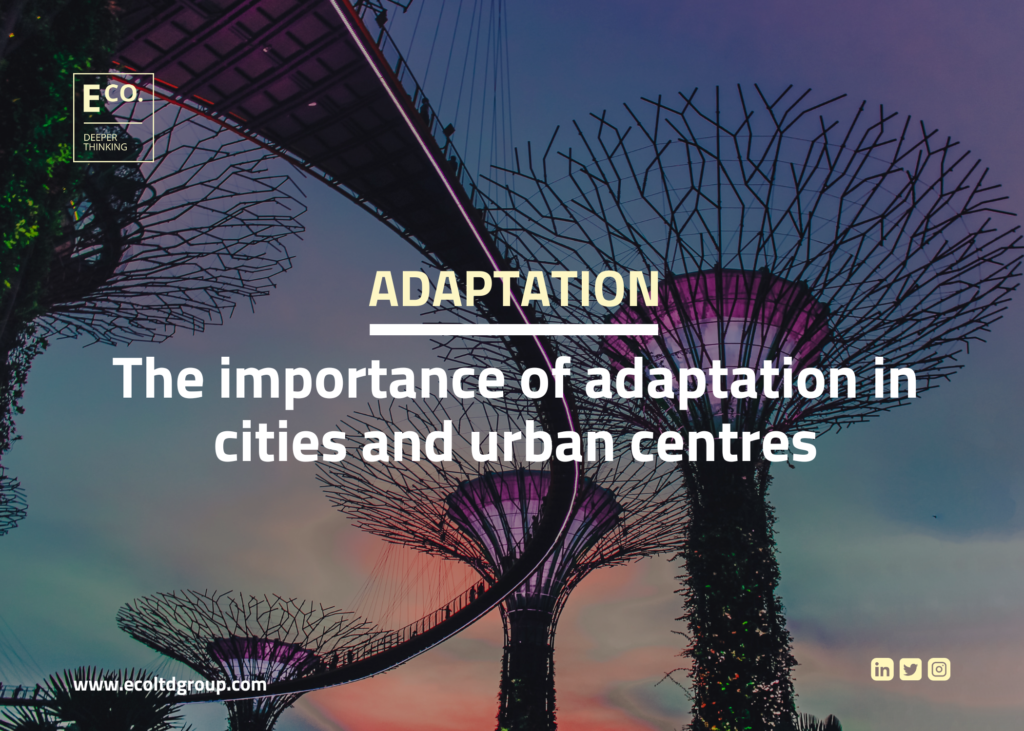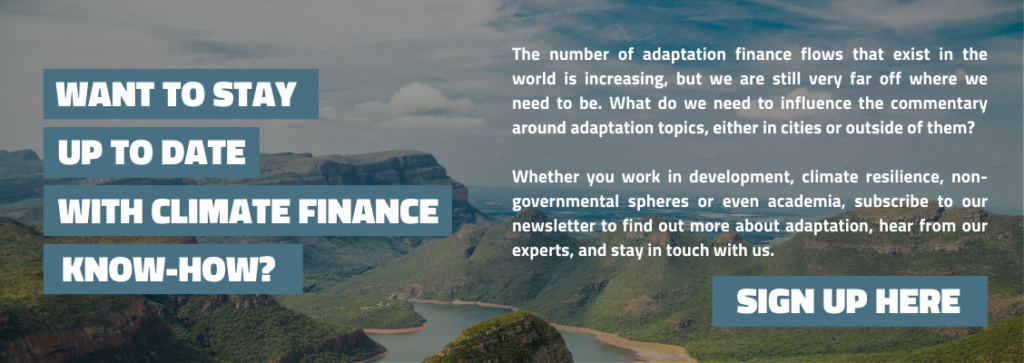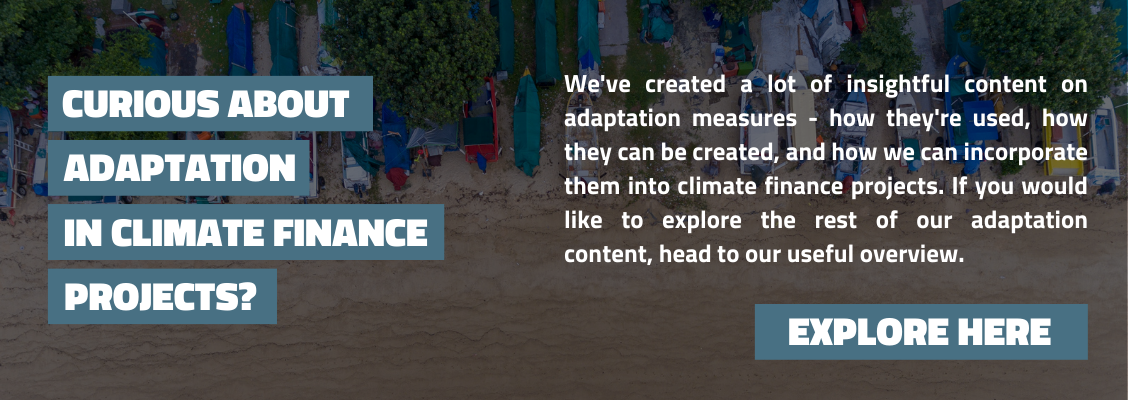The importance of adaptation in cities and urban centres
30 May 2023, Category: All insights, News, Tags: adaptation, adaptation finance, cities, climate change, climate finance, ecosystem based resilience, grey infrastructure, project design

It’s a well-known statistic: Over half of the world’s population lives in cities and urban centres. This state of affairs was quick to become the norm, as in 1960, the proportion of urban dwellers only represented 34% of the world’s population. Moreover, the distribution of the world’s urban population is changing. In 1960, 48% of the world’s urban population lived in Europe and North America. By 2020, less than a fifth of the urban population lives in these regions [1].
Now, because of the distinct place of cities as the main areas of human population (and, consequently, consumption and climate impact), they become a hotbed of issues if not properly acclimatised to the effects of present and future climate change.
In this article, we consider the place of cities as drivers of change, and what needs to be done to achieve this, exploring:
- Cities as an important space for championing effective adaptation measures;
- The current limits in adaptation financing in cities;
- Integrations that can be made between grey, green, and blue infrastructure.
Why cities? The case for adaptation in cities and urban centres
The pace at which urban populations are growing poses unique climate adaptation challenges and heightens exposure to climate change impacts such as flooding and heatwaves, as they host high densities of people, services, and infrastructure. Moreover, rapid urbanisation dynamics interacts with climate change, making urban areas vulnerable to compounding and cascading risks.
Worldwide, over 1 billion people live in informal settlements [2]. Climate impacts disproportionately affect the urban poor, where adaptive capacity is limited due to a range of factors such as tenure insecurity, inadequate housing, and lack of access to public services [3].
Nevertheless, cities also represent an opportunity in implementing effective and cost-efficient adaptation measures. Globally, cities can leverage the benefits of their economies of scale in terms of public goods and services (for e.g. transport infrastructure, water and sanitation, health systems). [4] Adaptation measures can be constructed in ways that solve, or at least ease, interrelated problems that cities face.
For example, take disease spread as a potential scenario. As cities continue to sprawl, the impacts of flooding due to sea-level rise and extreme precipitation events will be more severe in encroached land (usually floodplains or river basins). Once you combine this with poor housing and sanitation infrastructure, alongside high population densities, the incidence of water-borne and vector-borne diseases increases.
This is just one example–climate hazards have incredibly complex impact chains in urban areas by virtue of the types of land use, population density, and social inequality seen and experienced. The point here is that compounding issues make tackling climate risk even more difficult and important to solve.
The urban climate adaptation finance gap
Despite cities’ growing demographic and economic importance, there is limited investment in urban adaptation. Analysis conducted by the Climate Policy Initiative found that of the 30.8 billion USD destined to annual adaptation finance from 2017-2018, just over 5% had some urban adaptation potential. [5]
Other than the general barriers to financing adaptation actions, urban adaptation has its own set of challenges:
- Development Finance Institutions (DFIs) often face limitations imposed by their mandates and financial resources, which restrict them from directly investing in urban areas. Additionally, the financing procedures of international DFIs are primarily tailored for national-level government entities. [5]
- Municipal revenue types, particularly in developing countries, are limited to property tax and user fees rather than other more lucrative forms of revenue (income, fuel taxes, sales). This leads to a constrained financial capacity at the local level. [6]
- The allocation of urban function management responsibilities between city institutions and different government levels poses jurisdictional challenges. Moreover, cities often face constraints in terms of their fiscal authority. For example, if a local government agency is responsible for zoning while the national government holds budget authority, effective coordination becomes essential to secure financing for urban adaptation activities. On top of that, cities heavily depend on intergovernmental transfers from the national government to fund their budgets, which impairs their ability to plan at the city level. [6]
- Access to private and public sector finance is limited, particularly in developing countries. A World Bank analysis found that out of the 500 largest cities in 2013, only 4% were deemed creditworthy in international financial markets, and 20% in local markets in 2013. [7]
Towards urban resilience
Current adaptation finance in urban settings continues to be directed to large-scale grey infrastructure only. However, adapting to climate risks in cities and settlements can help reduce poverty and social inequity through integrated approaches.
For example, carefully designed nature-based solutions such as improved drainage systems (via improved soil cover, for example) can reduce flooding risk, with benefits for health and housing. Like other forms of adaptation, however, actions promoting urban resilience can lead to trade-offs with economic growth driven by infrastructure and housing investment. This is why municipal and city-level adaptation strategies need to integrate “soft” and green/blue infrastructure that deliver multiple adaptation benefits (e.g. through the deployment of nature-based solutions or social interventions), as extensions of existing physical infrastructure investments.
Ultimately, adaptation actions need to be mainstreamed into everyday decision-making within the local government level, in partnerships with national governments, and for the private sector and communities. By adopting a more participatory, inclusive, and holistic planning approach–one that considers local, non-state actors–the greatest gains in wellbeing and risk reduction can be achieved.

Looking for insight into climate finance? Look no further
Get in touch with our climate finance consultants to discuss a project you’re working on and create successful, fit-for-purpose projects, now and in the future. Email us at: amy@ecoltdgroup.com or find us at the following:
Twitter: @ecoltdnews
LinkedIn: E Co.
Instagram: @ecoltdnews
References
[1] https://www.iied.org/urbanising-world
[2] https://unstats.un.org/sdgs/report/2019/goal-11/
[3] https://www.ipcc.ch/report/ar6/wg2/downloads/report/IPCC_AR6_WGII_Chapter06.pdf
[4] https://royalsocietypublishing.org/doi/10.1098/rsta.2010.0350

Join the conversation by posting a comment below. You can either use your social account, by clicking on the corresponding icons or simply fill in the form below. All comments are moderated.